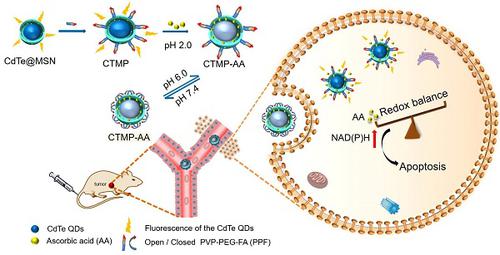当前位置:
X-MOL 学术
›
Theranostics
›
论文详情
Our official English website, www.x-mol.net, welcomes your feedback! (Note: you will need to create a separate account there.)
Ascorbic acid induced HepG2 cells' apoptosis via intracellular reductive stress.
Theranostics ( IF 12.4 ) Pub Date : 2019-01-01 , DOI: 10.7150/thno.33783 Xiaonan Gao 1 , Keyan Wei 1 , Bo Hu 1 , Kehua Xu 1 , Bo Tang 1
Theranostics ( IF 12.4 ) Pub Date : 2019-01-01 , DOI: 10.7150/thno.33783 Xiaonan Gao 1 , Keyan Wei 1 , Bo Hu 1 , Kehua Xu 1 , Bo Tang 1
Affiliation

|
Goals: Destruction of the redox balance in tumor cells is of great significance for triggering their apoptosis in clinical applications. We designed a pH sensitive multifunctional drug nanocarrier with controllable release of ascorbic acid under hypoxic environment to induce tumor cells' apoptosis via enhancing reductive stress, thereby dealing minimum damage to normal tissues. Methods: A core-shell nanostructure of CdTe quantum dots with mesoporous silica coating was developed and functionalized with poly(2-vinylpyridine)-polyethylene glycol-folic acid, which achieves cancer cells' targeting delivery and reversibly pH controlled release of ascorbic acid both in vitro and in vivo. Results: The result demonstrated that ascorbic acid can indeed lead liver cancer cells' death with the increase of nicotinamide adenine dinucleotide phosphate, while normal cells not being affected. The molecular mechanism of apoptosis induced by ascorbic acid was firstly elucidated at cellular levels, and further confirmed via in vivo investigations. Conclusion: For the first time we proposed the concept for applying reductive stress into cancer treatments, which brings great advantage of toxicity free and less damage to normal tissues. In general, this technique has taken an important step in the development of a targeted tumor treatment system, providing perspectives for the design of medicines via reductive stress, and offers new insights into future clinical mild-therapies.
中文翻译:

抗坏血酸通过细胞内还原性应激诱导HepG2细胞凋亡。
目标:破坏肿瘤细胞中的氧化还原平衡对于触发其在临床应用中的凋亡具有重要意义。我们设计了一种pH敏感的多功能药物纳米载体,在低氧环境下可控地释放抗坏血酸,以通过增强还原性应激诱导肿瘤细胞凋亡,从而对正常组织造成的损害最小。方法:开发了具有介孔二氧化硅涂层的CdTe量子点的核壳纳米结构,并用聚(2-乙烯基吡啶)-聚乙二醇-叶酸功能化,实现了癌细胞的靶向递送和抗坏血酸的pH可逆控制释放。体外和体内。结果:结果表明抗坏血酸确实可以导致肝癌细胞的凋亡。死亡与烟酰胺腺嘌呤二核苷酸磷酸的增加有关,而正常细胞不受影响。首先在细胞水平上阐明了抗坏血酸诱导的细胞凋亡的分子机制,并通过体内研究进一步证实。结论:我们首次提出将还原性应激应用于癌症治疗的概念,它带来了无毒且对正常组织的损伤更少的巨大优势。总的来说,这项技术在开发靶向肿瘤治疗系统中迈出了重要一步,为通过减轻压力的药物设计提供了前景,并为未来的临床轻度疗法提供了新的见识。并通过体内研究进一步证实。结论:我们首次提出将还原性应激应用于癌症治疗的概念,它带来了无毒且对正常组织的损伤更少的巨大优势。总的来说,这项技术在开发靶向肿瘤治疗系统中迈出了重要一步,为通过减轻压力的药物设计提供了前景,并为未来的临床轻度疗法提供了新的见识。并通过体内研究进一步证实。结论:我们首次提出将还原性应激应用于癌症治疗的概念,它带来了无毒且对正常组织的损伤更少的巨大优势。总的来说,这项技术在开发靶向肿瘤治疗系统中迈出了重要一步,为通过减轻压力的药物设计提供了前景,并为未来的临床轻度疗法提供了新的见识。
更新日期:2019-01-01
中文翻译:

抗坏血酸通过细胞内还原性应激诱导HepG2细胞凋亡。
目标:破坏肿瘤细胞中的氧化还原平衡对于触发其在临床应用中的凋亡具有重要意义。我们设计了一种pH敏感的多功能药物纳米载体,在低氧环境下可控地释放抗坏血酸,以通过增强还原性应激诱导肿瘤细胞凋亡,从而对正常组织造成的损害最小。方法:开发了具有介孔二氧化硅涂层的CdTe量子点的核壳纳米结构,并用聚(2-乙烯基吡啶)-聚乙二醇-叶酸功能化,实现了癌细胞的靶向递送和抗坏血酸的pH可逆控制释放。体外和体内。结果:结果表明抗坏血酸确实可以导致肝癌细胞的凋亡。死亡与烟酰胺腺嘌呤二核苷酸磷酸的增加有关,而正常细胞不受影响。首先在细胞水平上阐明了抗坏血酸诱导的细胞凋亡的分子机制,并通过体内研究进一步证实。结论:我们首次提出将还原性应激应用于癌症治疗的概念,它带来了无毒且对正常组织的损伤更少的巨大优势。总的来说,这项技术在开发靶向肿瘤治疗系统中迈出了重要一步,为通过减轻压力的药物设计提供了前景,并为未来的临床轻度疗法提供了新的见识。并通过体内研究进一步证实。结论:我们首次提出将还原性应激应用于癌症治疗的概念,它带来了无毒且对正常组织的损伤更少的巨大优势。总的来说,这项技术在开发靶向肿瘤治疗系统中迈出了重要一步,为通过减轻压力的药物设计提供了前景,并为未来的临床轻度疗法提供了新的见识。并通过体内研究进一步证实。结论:我们首次提出将还原性应激应用于癌症治疗的概念,它带来了无毒且对正常组织的损伤更少的巨大优势。总的来说,这项技术在开发靶向肿瘤治疗系统中迈出了重要一步,为通过减轻压力的药物设计提供了前景,并为未来的临床轻度疗法提供了新的见识。



























 京公网安备 11010802027423号
京公网安备 11010802027423号